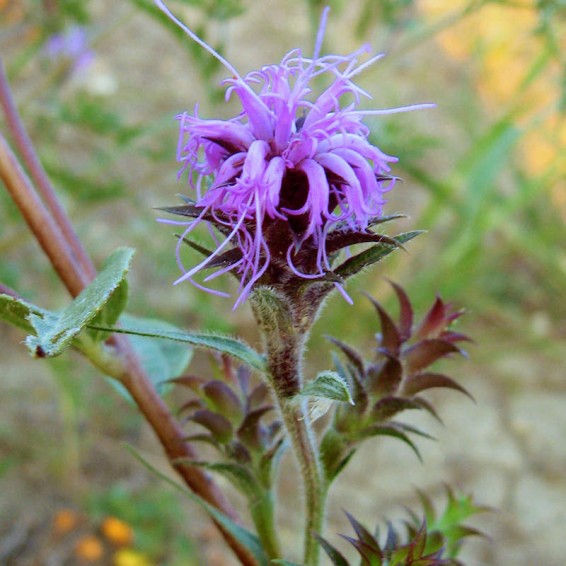Scaly Blazing Star Seeds
Liatris squarrosa
- HOW TO GROW
- FAST FACTS
HOW TO GROW
Sowing: Direct sow seeds in late fall, pressing them into the surface of the soil. For spring planting, mix the seeds with moist sand and store in the refrigerator for 60 days before planting; keep the soil lightly moist until germination, which usually occurs within 3-4 weeks at temperatures of 65-70 degrees F. This seed can also be started indoors 6-8 weeks before planting in the spring.
Growing: Young plants will need to be watered as they develop; because of the development of their extensive root systems, blooming usually does not occur until the second year of growth. Mature plants tolerate drought well, and can easily rot with too much moisture. After three or four years, the plants may need to be divided for the best growth. This should be done after blooming, when the plant has gone dormant. These plants attract bees, butterflies, and hummingbirds.
Harvesting: These blooms make excellent cut flowers. Choose stalks with about one third of the flowers open, and place them in water immediately; strip the foliage that will fall below the surface of the water. For dried flowers, hang the spikes upside down in a dry, warm place for about three weeks.
Seed Saving: When the flowers fade, they will eventually develop into a fluffy seed head. Since small birds love to eat the seed, harvest promptly to avoid loss. Cut the stems as soon as the fluff darkens slightly and can be removed. Spread the stalks out to dry away from direct sunlight. When they have completely dried, strip the fluff from the stems and clean it as well as possible. Store the seed in a cool, dry place.
FAST FACTS
Common Names: Colic Root
Latin Name: Liatris squarrosa
Species Origin: US Native Wildflower
Type: Native Wildflowers
Life Cycle: Perennial
USDA Zones: 5, 6, 7, 8, 9
US Regions: Plains/Texas, Midwest, Northeast, Southeast
Seeds per Ounce: 7,400
Stratification: Cold/Wet for 8 Weeks
Germination Ease: Stratify 8 Weeks
Sunlight: Full Sun, Part Sun
Height: 20 Inches
Color: Pink, Purple
Bloom Season: Blooms Late Summer, Blooms Early Fall
Uses: Attracts Pollinators, Attracts Honeybees, Attracts Butterflies, Hummingbirds, Cut Flowers, Deer Resistant
DESCRIPTION

HOW TO GROW
Sowing: Direct sow seeds in late fall, pressing them into the surface of the soil. For spring planting, mix the seeds with moist sand and store in the refrigerator for 60 days before planting; keep the soil lightly moist until germination, which usually occurs within 3-4 weeks at temperatures of 65-70 degrees F. This seed can also be started indoors 6-8 weeks before planting in the spring.
Growing: Young plants will need to be watered as they develop; because of the development of their extensive root systems, blooming usually does not occur until the second year of growth. Mature plants tolerate drought well, and can easily rot with too much moisture. After three or four years, the plants may need to be divided for the best growth. This should be done after blooming, when the plant has gone dormant. These plants attract bees, butterflies, and hummingbirds.
Harvesting: These blooms make excellent cut flowers. Choose stalks with about one third of the flowers open, and place them in water immediately; strip the foliage that will fall below the surface of the water. For dried flowers, hang the spikes upside down in a dry, warm place for about three weeks.
Seed Saving: When the flowers fade, they will eventually develop into a fluffy seed head. Since small birds love to eat the seed, harvest promptly to avoid loss. Cut the stems as soon as the fluff darkens slightly and can be removed. Spread the stalks out to dry away from direct sunlight. When they have completely dried, strip the fluff from the stems and clean it as well as possible. Store the seed in a cool, dry place.
FAST FACTS
Common Names: Colic Root
Latin Name: Liatris squarrosa
Species Origin: US Native Wildflower
Type: Native Wildflowers
Life Cycle: Perennial
USDA Zones: 5, 6, 7, 8, 9
US Regions: Plains/Texas, Midwest, Northeast, Southeast
Seeds per Ounce: 7,400
Stratification: Cold/Wet for 8 Weeks
Germination Ease: Stratify 8 Weeks
Sunlight: Full Sun, Part Sun
Height: 20 Inches
Color: Pink, Purple
Bloom Season: Blooms Late Summer, Blooms Early Fall
Uses: Attracts Pollinators, Attracts Honeybees, Attracts Butterflies, Hummingbirds, Cut Flowers, Deer Resistant



